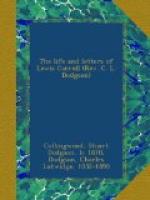It is interesting to know that Sir Noel Paton and Mr. Walter Crane were, in Lewis Carroll’s opinion, the most successful drawers of children: “There are but few artists who seem to draw the forms of children con amore. Walter Crane is perhaps the best (always excepting Sir Noel Paton): but the thick outlines, which he insists on using, seem to take off a good deal from the beauty of the result.”
He held that no artist can hope to effect a higher type of beauty than that which life itself exhibits, as the following words show:—
I don’t quite understand about fairies losing “grace,” if too like human children. Of course I grant that to be like some actual child is to lose grace, because no living child is perfect in form: many causes have lowered the race from what God made it. But the perfect human form, free from these faults, is surely equally applicable to men, and fairies, and angels? Perhaps that is what you mean—that the Artist can imagine, and design, more perfect forms than we ever find in life?
I have already referred several times to Miss Ellen Terry as having been one of Mr. Dodgson’s friends, but he was intimate with the whole family, and used often to pay them a visit when he was in town. On May 15, 1879, he records a very curious dream which he had about Miss Marion ("Polly”) Terry:—
Last night I had a dream which I record as a curiosity, so far as I know, in the literature of dreams. I was staying, with my sisters, in some suburb of London, and had heard that the Terrys were staying near us, so went to call, and found Mrs. Terry at home, who told us that Marion and Florence were at the theatre, “the Walter House,” where they had a good engagement. “In that case,” I said, “I’ll go on there at once, and see the performance—and may I take Polly with me?” “Certainly,” said Mrs. Terry. And there was Polly, the child, seated in the room, and looking about nine or ten years old: and I was distinctly conscious of the fact, yet without any feeling of surprise




